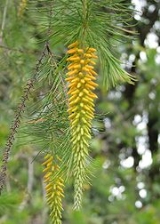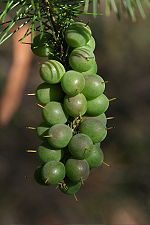
Persoonia pinifolia
Encyclopedia
Persoonia pinifolia, or Pine-leaved Geebung , is a large shrub which is native to the Sydney
region in New South Wales
, Australia
. It can reach up to 3 metres in both height and width. It has narrow linear leaves to 70 mm long and terminal flower racemes late winter to spring. These are followed by fleshy green fruits (drupes) that have the appearance of a bunch of grapes.
 It is one of the more widely cultivated Geebungs
It is one of the more widely cultivated Geebungs
in eastern Australia, though by no means common, and is a fairly reliable garden plant. The main reason it is not more widely available is the difficulties encountered in propagation by either seed or cuttings.
Seed is very difficult to germinate; a combination of inhibitors and a thick impermeable endocarp contribute to this notorious reputation. Under natural conditions fire appears to enhance germination, though the use of artificial smoke products seem to have no effect on improving the results. It can be assumed fire has a physical effect such as 'cracking' the endocarp or in association with water/rain/moisture improving permeability of the endocarp. It can also be assumed that smoke possibly does improve germination, but artificial conditions don't provide the means for smoke to permeate to the seed embryo.
Cuttings have been tried with many combinations of root-inducing hormones along with honey, sugar and coconut milk. The common rooting rate is < 1%. Results like this make the plant an unviable proposition for the professional nurseryperson and the amateur.
Sydney
Sydney is the most populous city in Australia and the state capital of New South Wales. Sydney is located on Australia's south-east coast of the Tasman Sea. As of June 2010, the greater metropolitan area had an approximate population of 4.6 million people...
region in New South Wales
New South Wales
New South Wales is a state of :Australia, located in the east of the country. It is bordered by Queensland, Victoria and South Australia to the north, south and west respectively. To the east, the state is bordered by the Tasman Sea, which forms part of the Pacific Ocean. New South Wales...
, Australia
Australia
Australia , officially the Commonwealth of Australia, is a country in the Southern Hemisphere comprising the mainland of the Australian continent, the island of Tasmania, and numerous smaller islands in the Indian and Pacific Oceans. It is the world's sixth-largest country by total area...
. It can reach up to 3 metres in both height and width. It has narrow linear leaves to 70 mm long and terminal flower racemes late winter to spring. These are followed by fleshy green fruits (drupes) that have the appearance of a bunch of grapes.

Persoonia
Persoonia is a genus of 98 species of shrubs and small trees in the tribe Persoonioideae in the large and diverse plant family Proteaceae. In the eastern states of Australia, they are commonly known as Geebungs, while in Western Australia and South Australia they go by the common name Snottygobbles...
in eastern Australia, though by no means common, and is a fairly reliable garden plant. The main reason it is not more widely available is the difficulties encountered in propagation by either seed or cuttings.
Seed is very difficult to germinate; a combination of inhibitors and a thick impermeable endocarp contribute to this notorious reputation. Under natural conditions fire appears to enhance germination, though the use of artificial smoke products seem to have no effect on improving the results. It can be assumed fire has a physical effect such as 'cracking' the endocarp or in association with water/rain/moisture improving permeability of the endocarp. It can also be assumed that smoke possibly does improve germination, but artificial conditions don't provide the means for smoke to permeate to the seed embryo.
Cuttings have been tried with many combinations of root-inducing hormones along with honey, sugar and coconut milk. The common rooting rate is < 1%. Results like this make the plant an unviable proposition for the professional nurseryperson and the amateur.

